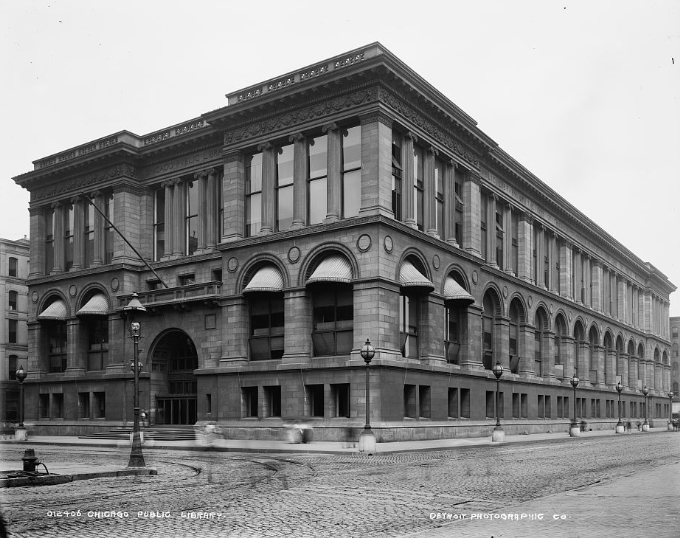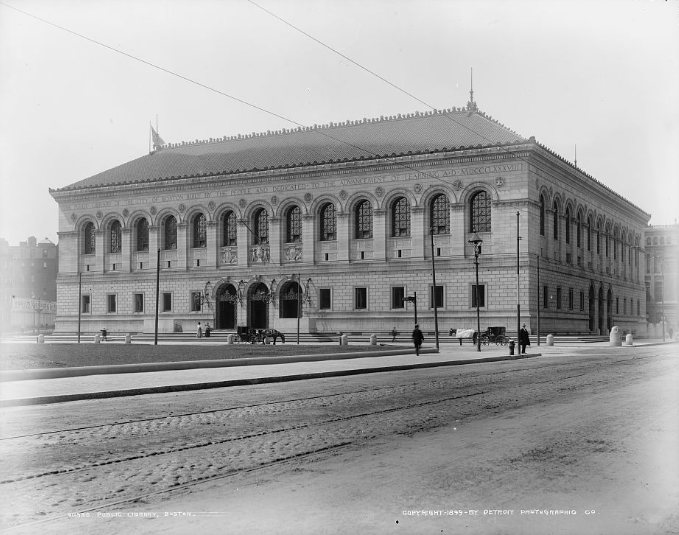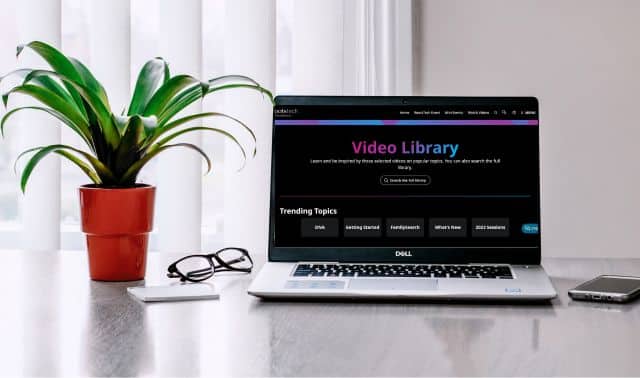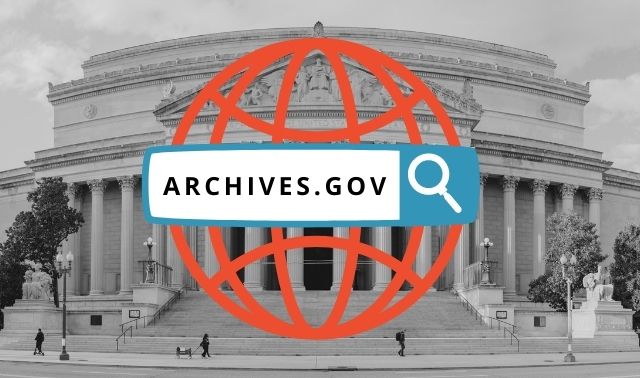Sign up for the Family Tree Newsletter Plus, you’ll receive our 10 Essential Genealogy Research Forms PDF as a special thank you!
Get Your Free Genealogy Forms
"*" indicates required fields
There’s never been a better time to brave big libraries. Shelves at major archives, historical societies and libraries are bursting with information. And librarians are welcoming genealogists with outstretched arms.
Even if you can’t get to one of the “Big Nine” genealogy libraries (see “Top Shelves“), chances are excellent that any large library or historical society archive near you can enrich your family history research. Of course, smaller libraries have genealogical treasures, too, often covering the local area. But if you’re not sure how to begin or you’re far from the place your ancestors lived, you may want to cast a wide research net at a library with a sizeable genealogy department.
“Big” libraries can help you find out more about your “small” family.

Chicago Public Library, dated 1890. Photo from Library of Congress.
So what’s holding you back from spending a day there? Think there won’t be any parking, or you won’t learn anything you haven’t already found out on the Internet? Worried you won’t know what to research or how to find materials you need?
Libraries offer an array of resources and, more important, the expertise of staff who know how to use them. Anyone can prepare for a successful—even enjoyable—visit to a library. It just takes planning, courage and persistence. In fact, you may even find the effort (or the exorbitant downtown parking fee) to be your best genealogy investment yet.
Scout it out
Large libraries serve audiences ranging from academic researchers to Joe Public. Can they really have decent family history collections?
You may be pleasantly surprised. “Big libraries have a lot to offer genealogists,” says Maira Liriano, assistant chief of the Milstein Division of US and Local History and Genealogy at the New York Public Library. “There are a lot of unique resources you might not find at the smaller places.”
Like what? US and state censuses. Vital statistics indexes. Regional and local histories. Biographical dictionaries. Cemetery records. Newspaper collections. Historical maps and city directories. Old diaries and family papers. And these are just the print offerings.
“Libraries are also great for accessing subscription databases that individuals and smaller societies can’t subscribe to or afford,” Liriano explains. “When you go to the library, you should be asking what databases it has—and not just the obvious ones. Other related products can be useful for genealogy research: digitized historical newspapers, government documents, pamphlets and all kinds of other things.”
Often you can preview a library’s holdings and database offerings on its Web site. Look first for a page targeted to genealogists that might summarize family history resources, such as the genealogy pages for the Los Angeles Public Library and Newberry Library. This information might reside within the history section or in an area labeled “digital resources.” Some libraries might list the history or genealogy department under the branch where it’s located, so if you’re not having any luck, look for a library locations section.
Finally, note the library’s location, hours, parking access, research fees and photocopying policies. Download our free Research Repository Checklist form to record these pertinent details. Print a map if you need it. You might even get lucky and find a virtual tour of the building, like the one on the New England Historic Genealogical Society site.
Go for the goal
The most-productive research trips begin with specific goals. “Start off with a five-generation chart,” suggests Ann Sindelar, a reference supervisor at Western Reserve Historical Society library in Cleveland. “It helps you organize data and sets the tone for your research strategy. It also helps a reference librarian see at a glance what you need.”
Your chart (which you can download from our Web site and fill in, or print from your genealogy software) can start with you or a remote ancestor, depending where you are in your investigation. It forms the backbone of the file you’ll take to the library.
Next, review your genealogy to-do list and the blank spots in your research. What are you most interested in learning? Would you like to flesh out one person’s life or identify the next generation back? Are you interested in an ancestor’s military service? What about his siblings or second marriage? Write down specific research questions.
Then compare your questions to the library’s holdings. Even if the archive doesn’t specialize in regions relevant to your heritage, they probably have collections that will be useful: historical maps, Civil War memorabilia, even an obituary database. Search the library’s online catalog. Don’t just enter a few surnames and call it quits. Information you need will likely be found under geographic, ethnic, historical or other topical search terms. Print the catalog listings of resources you need and note the names and call numbers (or locations) alongside the questions they might answer.
Add those to your library file, along with updated family group sheets, your research log and any biographical information you have for the ancestors you want to look for.
Your list of questions and potential resources constitutes your research strategy for this trip. This takes time to organize, but it also could prevent your becoming overwhelmed or sidetracked once you’re at the library.
Finally, consider calling ahead to make an appointment with a reference librarian. You may strike out if this is against library policy. Then again, you may discover the staff member who’s most expert in your topic is available only on Mondays, or in the afternoons. E-mailing ahead with a question or two might be just as productive; many library Web sites offer an “ask a librarian” option.
Brave the bastion of books
Boston Public Library. Dated 1899. Photo from Library of Congress.
Visiting a big library can be intimidating, especially if it’s on a prestigious college campus or in a busy urban neighborhood. Imposing architecture and an unfamiliar floor plan don’t help. Throw in a temperamental microfilm reader and a harried librarian, and even the most competent genealogist can feel at a loss.
“Those who want to research must be secure, adamant and strong,” says Craig Bara, a professional archivist and longtime family historian. “I have friends who’ve had bad experiences, especially older retired people who aren’t sure how to use the equipment. I’ve seen too many people walk away because they’re frustrated.”
How do you succeed at the library? Be professional. Keep the rules in mind. And be persistent in finding answers. Professionalism starts with how you look and how you treat the staff and other patrons. Wear neat clothing and carry just one tote bag (much easier to manage, and it’ll fit under your carrel where no one can trip over it). Above all, be respectful to library staff.
When he’s a guest in other archivists’ facilities, Bara says, “I try to remember this is their job, and to put myself in their place.” He counts on learning (and using) staff members’ names and making courteous requests. “Respect the librarians’ expertise,” he recommends, “and they’ll start pouring all kinds of information on you.”
Asking carefully considered questions also helps time-crunched staff. Pick up a floor map and use it to find the bathroom, manuscript room or elevator. Take your research as far as you can on your own. Then—without recounting your entire family history—ask targeted questions about what materials would be useful in your search.
Bara’s experience as an archivist helps him understand library policies, too. “Find out what the rules are and follow them,” he says. “A lot of people will pull a book off the shelf and put it back, even if a sign says not to. They don’t realize that librarians may keep track of what books are used.”
Look around for posted instructions. If you’re asked to rewind and return microfilm reels to their drawers, do so. When instructed, use white gloves, bookrests, pencils (instead of pens) for note-taking or other safeguards for handling fragile manuscripts. And as is common courtesy at any library, keep your table space tidy and your voice low.
Patience and persistence are Bara’s final keys to success. “I may need to wait my turn for crowded machines or the librarian’s attention,” he admits. “Or I may have to spend all day leafing carefully through fragile books of bound newspapers.”
Proceed methodically through your list of questions. Print, photocopy or digitally photograph documents (if you’re going to take pictures, practice with your camera ahead of time). Take notes on the answers you find (including conflicting details), and fully cite your sources. Fill in your research log. Note follow-up questions. And leave no stone unturned.
Return for more
“If you really want to know, you don’t give up,” Bara advises. “Don’t be afraid to dig and dig for answers. If you feel frustrated, take a break—and then come back. It’s amazing the energy you build, and then you’re able to think differently and go in a different direction.”
Your regional archive, university library or major public library may have what you need to break through your next research brick wall. So knock down any brick walls that are keeping you away from that library, and start planning your next trip. “Every library or archive is going to have unique information, whether it’s a collection or it’s in the mind of a librarian,” Sindelar says. “Sometimes it takes a little bit of courage. But the results for your genealogy research can be really compelling.”
A version of this article appeared in the September 2009 Family Tree Magazine
ADVERTISEMENT





